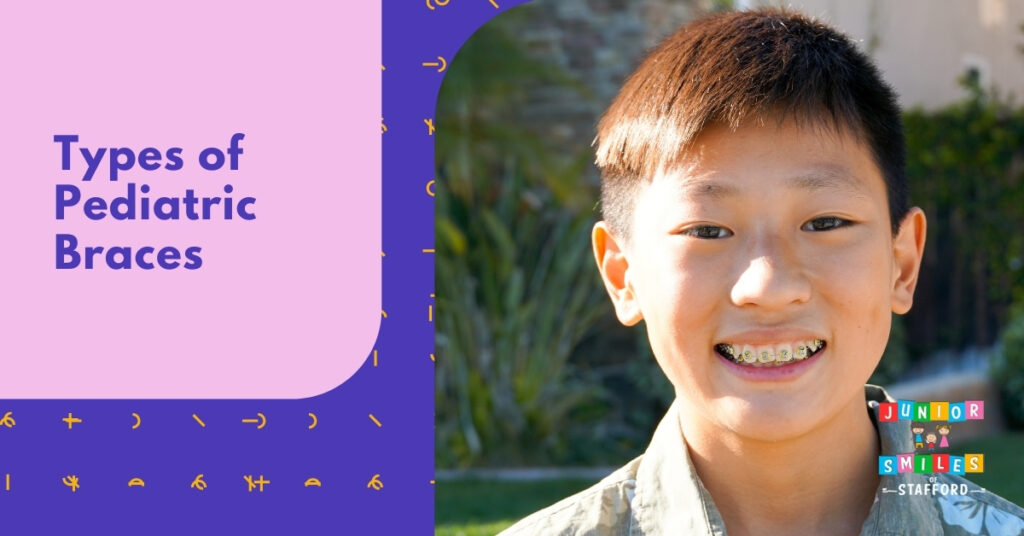Straight Smiles: A Comprehensive Guide to Braces for Kids

The first baby step toward a healthier, straighter smile is a big deal for any kid. Having said that, a little further assistance is sometimes necessary to get that seemingly flawless grin. Braces come into play in orthodontics to straighten and align those blossoming smiles. And as parents, you may have some worries and questions regarding the timing of therapy, the various braces that are available, and the proper way to take care of your child’s braces while they are in treatment. Rest assured, you have arrived at the correct spot. Everything a parent may want to know about getting their child braces is included in this comprehensive guide.
What are Braces For?
Among orthodontic treatments, braces have the most name recognition. Brackets, which can be either transparent or metal, are wired to the teeth. Braces are a great way to straighten the teeth and give your child a gorgeous smile.
Your child’s ability to eat and talk clearly will improve after getting braces to fix biting problems and misaligned teeth. By correcting overbites and underbites, braces can alleviate pressure on the jaw joints and forestall TMJ diseases. Teeth that are spaced out correctly are less likely to chip or suffer other wear and tear damage. In addition, braces can be a great way to prevent more extensive and expensive procedures down the road.
Does My Child Need Braces?
It is important to note that during the transition from primary to permanent teeth, the alignment of the new teeth may not always occur seamlessly. Frequently, these teeth arrive at a slight angle and gradually align themselves as they progress alongside your child’s growth and development. Rest assured, there is no need to panic or jump to conclusions about your child needing braces solely based on the early emergence of their adult teeth.
If you happen to observe that your child’s teeth are still misaligned or not properly positioned, or if your child displays any of the aforementioned symptoms, it is highly recommended to seek an evaluation from an orthodontist.
Reasons to Get Braces for Children
Think about taking your child to an orthodontist if they’re experiencing any of the following issues:
Crossbites
Braces are often necessary for children who suffer from a crossbite. When the lower and upper teeth don’t fit properly side to side or front to back, a condition known as a crossbites develops in the jaw.
Damage to teeth, discomfort in the jaw, and uneven jaw development are all symptoms of a crossbite. Severe cases of crossbite, if left untreated, may necessitate major jaw surgery and more comprehensive therapy down the road.
Space Concerns
A misaligned set of teeth can sometimes coexist with a perfectly healthy bite. Unattractive as they are, gaps between teeth might cause more serious problems in the future. For the purpose of achieving ideal spacing and straight tooth growth, orthodontic braces are utilized by orthodontists.
Lost Baby Teeth too Early or too Late
Braces may or may not be necessary for your child depending on when they lose their baby teeth. Although it’s not common for children to lose their baby teeth at a young age, it might happen due to injuries or tooth rot. A variety of dental issues, including the need for braces, can arise when a kid has premature tooth loss.
Loss of baby teeth at an abnormally late age is another possibility. This could lead to misalignment of their teeth when they get their permanent teeth. By the time your child is six or seven years old, babies should have loosened their teeth. Make an appointment with the dentist if your child’s baby teeth fall out at any point before or after this.
Mouth Breathing
Has your little one started to breathe through their mouth? Therefore, braces could be necessary along the road. Problems with facial features could result from breathing via the mouth all the time. This can affect how their permanent teeth develop; for instance, if their jaws are too small, their teeth won’t have enough room to erupt.
Your child’s oral health is at risk for additional issues, such increased tooth decay, due to mouth breathing. It is critical that you take your child to the dentist regularly if they breathe through their mouth.
Thumb Sucking
Children may require braces at a young age for a variety of reasons, one of which being the development of thumb-sucking behaviors that often begin around the age of seven or later. If you want to avoid serious issues with their jaw and teeth alignment, they need to stop sucking their thumbs immediately.
Types of Braces for Kids: Exploring Options
Modern dental technology has made it possible to offer a wide range of braces to cater to individual tastes and demands. A variety of braces are available for children, and some of these are below:
Traditional Braces
This is the standard bracing option; the brackets are fastened in place using steel ties. Their efficiency is well-known, particularly when it comes to fixing serious misalignments. This form of braces allows children some personalization options, and many prefer to wear them with colored bands.
Invisalign
Aligner systems that are transparent, like Invisalign, make it possible to straighten teeth without anybody noticing. These removable aligners are a solution that is both comfortable and unobtrusive because they are custom-made. Just like a mouthguard, these cover the teeth invisibly.
Lingual Braces
Lingual braces, also known as invisible braces, are discreetly positioned behind the teeth, making them virtually undetectable when viewed from the front. These custom-made products are meticulously designed to perfectly fit the unique structure of every child’s mouth.
Damon Braces
Unlike conventional braces that rely on steel ties to secure wires, Damon braces utilize a self-ligating system. This means that the brackets themselves are responsible for holding the wires in place, eliminating the need for additional steel ties. This innovative approach not only enhances the aesthetic appeal of Damon braces but also offers potential advantages in terms of comfort and efficiency.
How Much Do Braces Cost for Kids?
The time and effort put into braces therapy, as well as the specific type of treatment, might affect the final price tag. While clear aligners can add a significant financial burden, traditional metal braces are usually the most budget-friendly choice. You and your orthodontist should talk about how much treatment will cost and look into different payment alternatives like insurance or payment plans.
How to Afford Braces for Your Child: Insurance Options
Typically, half of the entire cost is due at the first appointment, with the remaining half due at each subsequent dentist appointment for both metal and ceramic braces. In most cases, patients who get Invisalign from an orthodontic office will need to pay half up front and the other half at their scheduled dental appointments spaced two to three months apart. During these appointments, you will get fresh Invisalign aligners and take dental impressions. If you are able to do so, you may sometimes get a discount on orthodontic treatment if you pay for part or all of it up front. Don’t hesitate to ask for any discounts, as braces can be quite expensive.
Orthodontia is also partially covered by many dental insurance policies, particularly for children and young adults. It’s smart to familiarize yourself with the coverage details and insurance claim processes by reviewing your policy or having a thorough conversation with your insurance provider. It may also be prudent to pay for orthodontic treatment using pre-tax cash from a flexible spending account (FSA) or health savings account (HSA). Your orthodontic treatment, like other qualified medical costs, can be paid for tax-free with the help of one of these accounts.
Advantages of Early Orthodontic Treatment
Starting treatment at the appropriate age allows the underlying bones to mature, which in turn allows the permanent teeth to grow into the proper spacing. To top it all off, the procedure can help fix underdeveloped jawbones. Straightening your child’s teeth at a young age will make cleaning their teeth easier and reduce the likelihood that they will experience unnecessary dental issues on the road. The use of orthodontic equipment can also start the process of straightening teeth, ensuring that permanent teeth erupt in the right places. Orthodontic therapy for children while they are young can correct malocclusions and allow their mouths and teeth to grow in the best possible way. Because the bones are still growing and more readily manipulated while a child is young, treating biting disorders is considerably simpler and faster when done while the child is young.
Braces for Kids FAQs
What are the benefits of pediatric braces?
Braces are a highly effective solution for addressing a wide range of orthodontic issues. These include but are not limited to crooked teeth, overbites, underbites, and crossbites. By opting for braces, kids can achieve significant improvements in their dental alignment and overall oral health. In addition to enhancing your child’s smile, orthodontic treatment can have a positive impact on their speech and ability to chew food effectively.
What is the best age for children to get braces?
The average age that an orthodontist will suggest braces is 9, while some may suggest them for children as young as 6 or 7.
By the time your child is nine, all of their permanent teeth will have come in. However, in extreme circumstances, an orthodontist may suggest early intervention services for your kid. Some orthodontic issues, such overbites and crowding of teeth, may be best addressed by an orthodontist at an earlier stage.
How painful are braces for kids?
Braces are typically not associated with significant discomfort. Many individuals may experience a sense of pressure during the procedure, however, it is important to note that the overall process is not considered to be painful.
Get the Best Orthodontic Treatment for Your Kid at Junior Smiles
Getting braces for a youngster is typically the final resort when dealing with dental problems. They make it possible for a youngster to correct their teeth all at once while reducing the likelihood of permanent orthodontic problems. In addition to enhancing your child’s smile, braces can boost their confidence and general well-being. In order to help your child achieve a healthier, happier smile, it is important to weigh the expenses, life effect, and advantages of braces. This will allow you to make an informed decision. If you want to create a unique treatment plan for your child’s orthodontic issues, it’s important to talk to a reliable orthodontist.
When looking for a pediatric clinic in Stafford, VA, one of the top options is Junior Smiles of Stafford. To guarantee that your child receives the finest care possible, they have state-of-the-art equipment and a staff of specialists. Visit the most reliable pediatric dentistry practice in Virginia by scheduling an appointment now.

